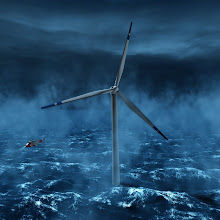
Wind is extremely energetic, since the force of nature is created by air traveling at significant velocities. As an illustration, all the wind in the United States can generate one and a half times the United States' electricity consumption. This potential ignited a huge desire for the world to use wind power, but wind power may be limited by the supply of turbines that are needed to harness the wind's kinetic energy. In fact, according to General Electric, there is a $12 billion backlog on wind turbines. With this enormous demand, though, the world may become too dependent on wind power, and winds can be highly variable, becoming more or less energetic. Less energetic winds, in particular, are harmful for a world dependent on wind power, as wind turbines then harvest less power, which may devastate cities that rely on the power source. Also, wind turbines may be unstable if they malfunction, as evidenced by the attached video on the bottom.
Wind turbines, even if they operate without errors or decreases in energy production, may impact the environment, not through greenhouse gases, but through the deaths of birds and bats. At the Altamont Pass Wind Area, the oldest commercial wind farm in America, an estimated ten thousand birds are killed every year, and, annually, one hundred thousand birds are believed to be killed by wind turbines nationwide. Most of these deaths, though, occur in three Californian wind farms, in which the turbines were constructed in the early 1980's, implying that new technology may not be as dangerous to birds. Also, the number of birds killed at wind farms is relatively small compared to the millions of birds killed in collisions with human creations, like cars and windows. Bats, however, are not normally killed at any human structures, but at the Mountaineer Wind Energy Center, hundreds of bats died in one night. Scientists cannot provide data on the number of bats killed at wind farms every year, but some estimates report that, at wind farms, three to five bats are killed for every bird that is killed. Scientists are still researching a solution to this problem, but the Bats and Wind Energy Cooperative has begun testing the effect of stopping wind turbines during periods of low wind velocities on bat deaths, in effect taking advantage of a drawback of wind power to negate a much larger drawback. This strategy may help make wind power a staple renewable energy source in the future, but further development should be stalled until scientists eliminate the effects wind turbines have on bat and bird populations.
P.S.: Here is the video I mentioned earlier.


4 comments:
Tommy,
Obviously there is a dilemma between animal protection and wind energy. The idea of stopping turbines during periods of low wind velocity is intriguing because it benefits the animals and does not harm turbine owners and consumers. The fact that man-made machines such as cars kill many more birds each year compared to turbines says to me that turbines shouldn't directly affect the bird population in the future and this only leaves bats. Is the number of bats killed by turbines significant enough to really affect the population, and if so how might scientists improve on turbines to reduce the risk?
Caitlin,
The idea of stopping turbines during periods of low productivity, as I said earlier, is still being tested for its impact on bat deaths and energy production, so I cannot draw any assumptions or conclusions. On the bird population, most bird deaths occur at old wind farms, implying that new technologies have halted this problem. On the number of bats killed by turbines, though, scientists can only vaguely estimate the number of bat deaths, and the same drawback likely holds for bat populations. This uncertainty prevents scientists from seeing the severity of bat deaths on bat populations. As I said before, scientists are testing briefly stopping turbines to see the effect on bat deaths. If that approach fails, scientists may try moving wind farms or altering the structure of the turbine, but until any solutions present themselves, bats may continue to die, especially given the immense demand for wind power development.
Tommy
Tommy,
Of course bird and bat deaths will be noticed in rural places. If bird deaths are tallied at places of migratory and nesting paths, then obviously the death rate will be high. However, is it possible to just move the turbines to another location that's less prone to an influx of birds? The small number of birds killed in these places would not affect the population very much, if at all.
-Emily
Emily,
On bird deaths, there are many bird migratory routes, but the three wind farms in California I mentioned earlier are responsible for the most bird deaths, and these farms were constructed in the 1980's. Most modern wind farms seem to possess far fewer bird deaths than those three old farms. On moving the turbines, if you follow the third link in my post, you will find that one wind energy company has already moved one proposed wind farm about 150 feet to avoid killing flying animals. Bat deaths, however, are much more prominent since bats are usually not killed by human structures. Finally, you cannot underestimate the impact these deaths can have on bird and bat populations, and humanity should try to reduce these deaths to an absolute minimum.
Tommy
Post a Comment